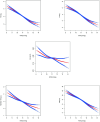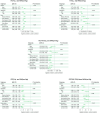The negative association between weight-adjusted-waist index and lung functions: NHANES 2007-2012
- PMID: 39441792
- PMCID: PMC11498673
- DOI: 10.1371/journal.pone.0311619
The negative association between weight-adjusted-waist index and lung functions: NHANES 2007-2012
Abstract
Obesity is a common public health issue worldwide, and its negative impact on lung function has garnered widespread attention. This study sought to investigate the possible association between a new obesity metric, the weight-adjusted waist index (WWI), and lung functions, providing a basis for the monitoring and protection of lung functions. We conducted a cross-sectional evaluation, analyzing data from adults in the U.S. gathered through the National Health and Nutrition Examination Survey (NHANES) from 2007 to 2012. To explore the correlation between WWIs and lung functions, we utilized a multivariate logistic regression model with appropriate weighting to ensure accuracy. Smooth curve fitting also helped to confirm the linear nature of this relationship. Subgroup analyses were conducted to confirm the uniformity and dependability of the results. Our study included data from 13,805 adults in the United States. Multivariate linear regression analysis revealed that, in the fully adjusted model, higher WWIs were negatively correlated with forced vital capacity (FVC), forced expiratory volume in the first second (FEV1), FEV1/FVC, peak expiratory flow rate (PEF), and forced expiratory flow rate (FEF) 25%-75% (β = -0.63; 95% confidence interval [CI] [-0.71, -0.55]; β = -0.55; 95% CI [-0.62, -0.48]; β = -0.02; 95% CI [-0.03, -0.01]; β = -1.44; 95% CI [-1.65, -1.23]; β = -0.52; 95% CI [-0.65, -0.39], respectively). Additionally, when analyzing the WWI as a categorical variable, a significant downward trend in the FVC, FEV1, PEF, and FEF 25%-75% was observed from Q2 to Q4 as the WWI increased (trend P < 0.05). Subgroup analysis showed stronger associations between WWI and lung functions, particularly among younger, non-Hispanic white, male participants, and current smokers. Our results indicate that elevated WWI is strongly associated with declining lung functions, demonstrating the importance of long-term monitoring and tracking of WWIs.
Copyright: © 2024 Fan et al. This is an open access article distributed under the terms of the Creative Commons Attribution License, which permits unrestricted use, distribution, and reproduction in any medium, provided the original author and source are credited.
Conflict of interest statement
The authors have declared that no competing interests exist.
Figures



Similar articles
-
Association between waist circumference and lung function in American middle-aged and older adults: findings from NHANES 2007-2012.J Health Popul Nutr. 2024 Jun 26;43(1):98. doi: 10.1186/s41043-024-00592-6. J Health Popul Nutr. 2024. PMID: 38926790 Free PMC article.
-
Association between weight-adjusted waist index and testosterone deficiency in adult American men: findings from the national health and nutrition examination survey 2013-2016.BMC Public Health. 2024 Jun 24;24(1):1683. doi: 10.1186/s12889-024-19202-5. BMC Public Health. 2024. PMID: 38915014 Free PMC article.
-
The association between Weight-adjusted-Waist Index (WWI) and cognitive function in older adults: a cross-sectional NHANES 2011-2014 study.BMC Public Health. 2024 Aug 8;24(1):2152. doi: 10.1186/s12889-024-19332-w. BMC Public Health. 2024. PMID: 39118100 Free PMC article.
-
Association of weight-adjusted waist index with hyperuricemia and gout among middle-aged and older adults in America: a cross-sectional analysis of NHANES 2007-2014.Clin Rheumatol. 2024 Aug;43(8):2615-2626. doi: 10.1007/s10067-024-07011-5. Epub 2024 Jun 11. Clin Rheumatol. 2024. PMID: 38861229
-
Association between Weight-Adjusted Waist Index and depressive symptoms: A nationally representative cross-sectional study from NHANES 2005 to 2018.J Affect Disord. 2024 Apr 1;350:49-57. doi: 10.1016/j.jad.2024.01.104. Epub 2024 Jan 12. J Affect Disord. 2024. PMID: 38220117 Review.
References
-
- Heymsfield SB, Wadden TA. Mechanisms, Pathophysiology, and Management of Obesity. The New England journal of medicine. 2017;376(3):254–266. - PubMed
-
- Piché ME, Tchernof A, Després JP. Obesity Phenotypes, Diabetes, and Cardiovascular Diseases. Circulation research. 2020;126(11):1477–1500. - PubMed
-
- Kulkarni K, Karssiens T, Kumar V, Pandit H. Obesity and osteoarthritis. Maturitas. 2016;89:22–28. - PubMed
MeSH terms
LinkOut - more resources
Full Text Sources

